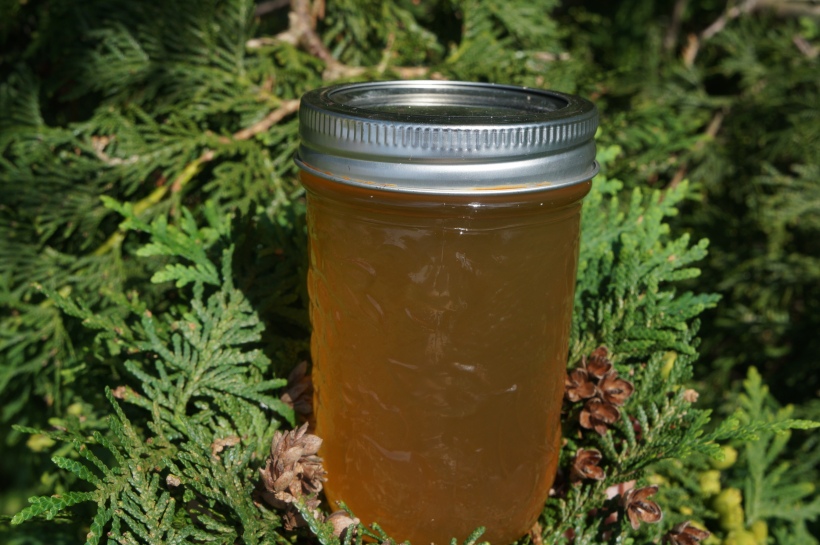If you are one who enjoys grilled game, fish or fowl, this aromatic jelly is for you. And if you’re not one to consume any of those, you will still enjoy this with cheese and bagels, or simply on toasted sourdough bread. Either way it is a perfect condiment for any larder.
Even knowing that cedar is one of the many flavourful and scented evergreens native to this region, I have hesitated to use it up till now. It contains a chemical called thuja which should not be consumed in large quantities, and definitely should be avoided by pregnant and nursing women. Recently I watched a cooking show about pre-colonial recipes, and noticed they used a cedar jelly as an accompaniment to game, so I figured that the quantities of thuja in this had to be tolerable. On further researching, I discovered that there are several greens which contain this chemical, most notably juniper, some mints and sage, all of which are found in most cooks’ pantries. I also learned that early settlers used the leaves to make tea to prevent scurvy, and many campers continue to use it as an available source for a tasty drink. I therefore concluded that making a cedar jelly recipe to be consumed occasionally in small amounts would be delicious and safe, as long as you are not pregnant or nursing.
The cedar tree I am referring to is one that is commonly found in the north eastern parts of North America – the eastern white cedar. There is a similar western version, but I am only familiar with the one from this zone. It is a fast growing, hardy conifer favoured in landscaping but also easy to find in the wild. Its small scaly leaves cover the fan-shaped twigs and vary from yellowish to deep green. Its small cones grow in clumps of five or six pairs.
 Three things to note about cooking with these leaves are:
Three things to note about cooking with these leaves are:
keep the simmering or steeping mixture covered to prevent the volatile oils from escaping;
use only the lighter green tips growing from sill-green branches;
the longer the cooking process, the more flavour will be lost.
So bearing these in mind, here is the recipe I came up with.
Cedar Jelly
Ingredients
2 cups cedar leaves
2 cups water
2 cups sugar
juice of 1 lemon
1 pkg (85 ml) liquid pectin
Method
Place the leaves and water in a jar and press the leaves down to submerge. Cover with a lid and set in the sun for at least four hours. This will extract a good amount of flavour without cooking it.
Strain the liquid, add the sugar, lemon and pectin. Bring to a boil and simmer for about 10 minutes, until foam forms on the top. Skim off the foam and bottle.
To date, I have no way of measuring the ph level for purposes of canning, so I am just freezing as my method of storing. This recipe makes three 8 oz jars.

Linked to: Fiesta Friday #184; Food Eat Love; The Not So Creative Cook.

August 11, 2017 at 3:34 pm
This looks so interesting to me! It sounds really good, too! Thanks for sharing at Fiesta Friday party!
LikeLiked by 1 person
August 16, 2017 at 2:34 pm
I love to read your recipes. This sounds delicious and unique! Thank you for sharing with us at FF! 🙂 I hope your week is good!
LikeLiked by 1 person
August 16, 2017 at 4:06 pm
This is so cool & so unusual for me! waw!
LikeLiked by 1 person
Pingback: Balsam Fir Body Scrub | Along the Grapevine
Pingback: 6 Kinds of Jams and Jellies You Didn’t Know You Could Make | Dusty Old Thing